Some people are natural-born decision-makers.
They view simple problems the same way they see complex ones. So, for example, what to eat for lunch (simple) is the same as where to go to college (complex) or whether (and when) to take a new product to market (business complex).
The net result: These “natural-born decision-makers” smash through mental barriers, avoid procrastination, and overcome obstacles relatively easily.
While people like that may seem superhuman, it’s far more likely they’ve built confidence by knowing which tools to use and when to use them.
One such tool … the Pareto chart.
Systems like the Pareto chart are game-changers for people wanting to influence high-impact, essential organizational shifts.
This article will share the origin of the Pareto principle, the definition of a Pareto chart, and detail how to make a Pareto chart to boost overall effectiveness.
What is the Pareto principle, and how does it work?
In the late 19th century, an Italian economist and engineer named Vilfredo Pareto made a groundbreaking discovery that rocked the world of microeconomics.
His discovery — known as the Pareto principle (or 80/20 rule) — rightfully became his namesake because of its profound impact on the world at the time … and still today.
The Pareto principle states that for most outcomes, 80% of consequences come from only 20% of the causes. It’s a power-law distribution that isn’t always precisely 80/20, but it’s often quite close.
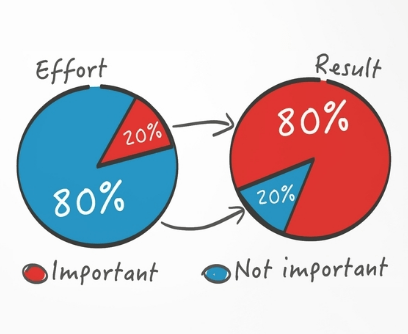
Mr. Pareto noticed that roughly 80% of Italy’s land belonged to only 20% of the population. As he surveyed other countries, he found the same distribution often held.
Upon further examination, he concluded the “80/20 rule” applied to nearly everything. He even found that just 20% of the pea pods in his garden produced almost 80% of the peas.
While the Pareto principle’s roots are in economics and process improvement, it’s found its way into modern culture.
These days the Pareto principle comes up a lot when discussing techniques for boosting productivity. However, there are countless examples of how it applies to real-world applications.
- Wealth distribution
- Federal income tax payment: In 2018, 20% of Americans ended up paying 87% of income taxes)
- Programming errors & bugs: In the early 2000s, Microsoft found that 80% of errors were caused by just 20% of the bugs detected.
- Software features: Microsoft also found that their users used roughly 20% of the overall features.
The list of applications of the principle is endless and is rarely exactly 80/20, but it’s often quite close.
What is a Pareto chart?
Now that we’ve established a working understanding of the Pareto principle, we can move on to the Pareto chart.
In technical terms, a Pareto chart is a tool that highlights the frequency of defects alongside their cumulative total impact.
In plain terms, a Pareto chart is a line and a bar chart that shows where to focus your efforts and see the most significant results.
The idea is to identify the 20% of the changes that will yield the greatest results. This enables you to move on to what the scientific community calls PDSA testing or Plan-Do-Study-Act.
- Plan: Create a test.
- Do: See it through to completion.
- Study: Review the results.
- Act: Take action based on what you’ve learned.
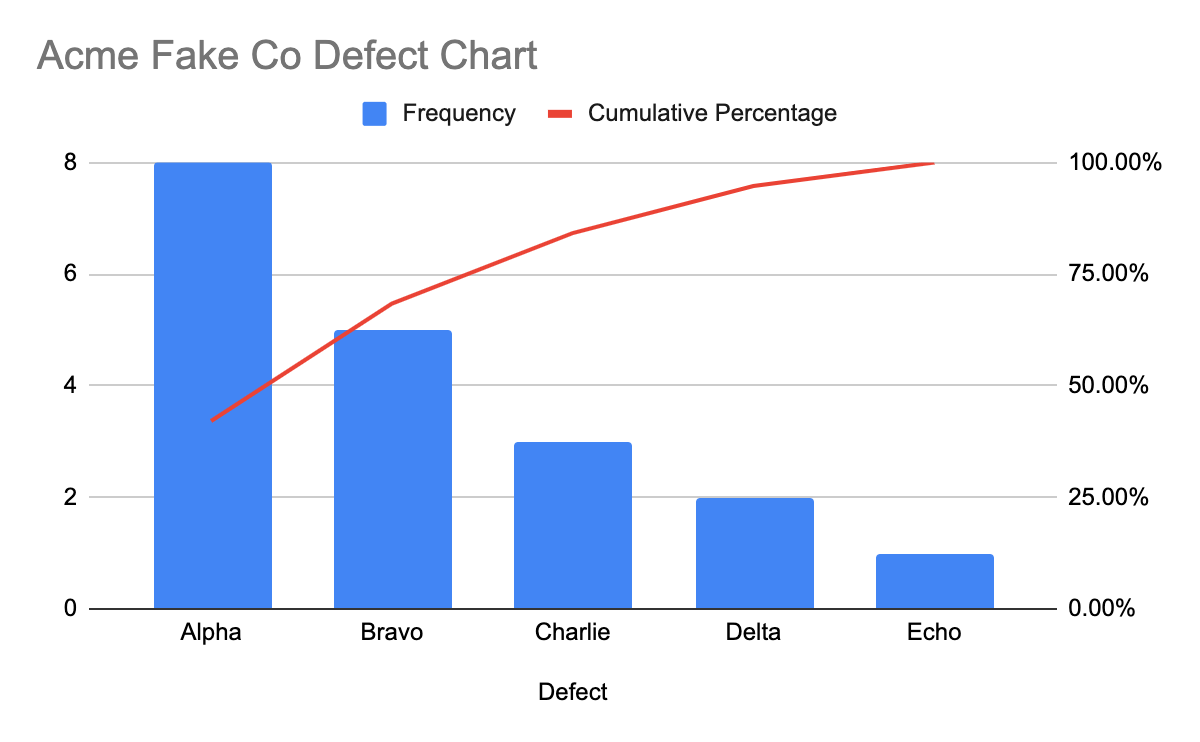
combines a bar graph and line chart.
The Y-axis (vertical axis) on the left-hand side shows the frequency of occurrences.
The X-axis (horizontal axis) across the bottom lists the categories.
The (other) Y-axis across the right-hand side shows the percentage of cumulative frequency.
As you track the data from the collection form, list them from most frequent to least frequent on the bar chart.
In terms of defects, you’d see the chart on the left with the highest bar has the most defects and will gradually drop off as the chart moves to the left.
The line chart shows the cumulative percentage of problems or defects — measured on the right side. The line intersects with the bar chart to help identify the 80/20 rule.
Kinda neat, right?
Why is a Pareto chart important?
Shortcuts and automation are the names of the game in the 2020s. Do more with less.
Doing more with less is tough to just … do. You need help.
monday.com research found that 63% of people believe they’re missing an opportunity to show their best work. A big part of that likely boils down to companies working on the wrong projects.
The general idea behind using a Pareto chart is to aid with prioritizing tasks.
The Pareto effect helps identify the vital 20% that, if prioritized, will yield the most significant total impact.
The Pareto chart provides a repeatable and systematic approach to finding errors, defects, and problems. Companies that can consistently find bottlenecks or ways to improve their processes require less staff, fewer materials, and make greater profits.
With a Pareto chart, your organization has a laser-focused view of the problems and defects slowing you down or costing you money.Without that line of sight, you’re susceptible to further errors and defects, which make your team less efficient, cause further wasted materials, and damage your brand’s reputation if it becomes synonymous with problems or defects.
Who uses Pareto charts?
While the Pareto principle has its roots in economics and engineering, its use today varies widely. The Pareto chart is especially useful in the manufacturing industry.
Proponents of the Lean 6 Sigma managerial approach constantly seek ways to improve performance by eliminating manufacturing defects and waste.
The Pareto effect helps visualize where the bulk of opportunities (or problems) in a process originates. Tackling the largest sources of inefficiency up front means companies will make their greatest improvements with the least effort.
Win. Win.
A real-world example of Pareto chart usage is how the Arizona Registrar of Contractors (AzROC) uses them. The AzROC maintains contractor licenses, adopts set construction standards, enforces policies and procedures, and investigates violators.
They use Pareto analysis to assess the criteria most important to their customers and determine process flows to match to ensure they’re addressing their needs with the greatest impact upfront.
Now that you have the Pareto chart foundations let’s see how you can take advantage of all it offers.
A 5-step guide to creating your Pareto chart
By now, you probably realize the full scope and power a Pareto chart can offer your organization. There’s also a good chance you’d like to dive right in to create one for yourself.
Well, you’re in luck. Even if you only have rudimentary spreadsheet skills, you can create one on your own.
Here are 5 steps to creating your own Pareto chart today:
1. Gather your data
Before you do any creation-related work, you need data — data to help create your first Pareto diagram.
Note: If you have data in spreadsheets already, you can skip this step. If you have data in a software system, export it.
At monday.com, we pride ourselves on providing an ultra-secure data storage solution so you can store all sorts of data, from customer information to product order information.
With monday.com, exporting your data to Excel is as easy as clicking into the 3 dots at the top right corner of every board, selecting More actions, and Export board to Excel.
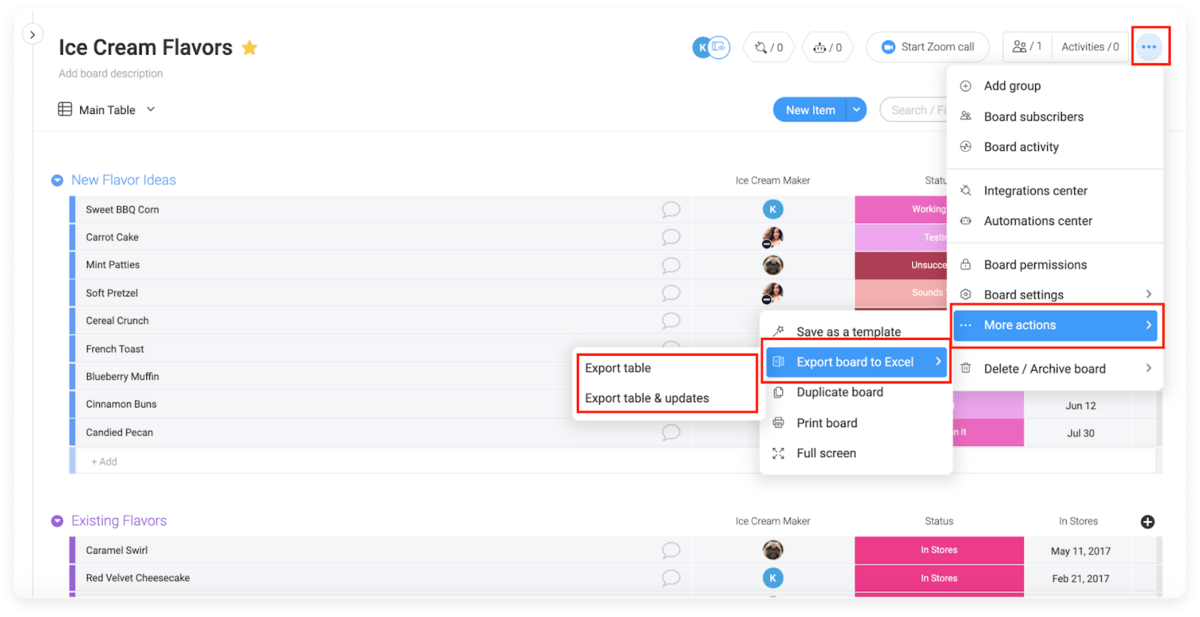
From there, you can decide to export it as a simple table or a table & update. A simple table works perfectly for our purposes since you just need the core data.
Note: “Table & updates” will create another tab with all corresponding updates, replicas, and activity for reference.
When you don’t have your data readily available, you can always use monday.com to collect your data, either by creating a new board or by creating a survey.
All it takes to create a survey is a simple board with the right mix of columns — questions or prompts necessary to gather data, a date, an address, and an assignment.
Once you’ve got that ready, copy that unique link and send it out.
2. Organize the data
Organizing the data just means putting it together in a format conducive to creating a Pareto chart.
Some specialized statistical software and chart generation tools are fully capable of creating Pareto charts and performing Pareto chart analysis, but we’ll stick with more simple solutions.
Most people still use Excel, but Numbers, Google Sheets, LibreOffice, or your go-to spreadsheet application will work fine.
For our purposes, we’ll be using Google Sheets since it’s free, easy to use, and it’s one of monday.com’s dozens of integrations. We’ll also use manufacturing defects as an example.
First, create a title row at the top and type Defect in cell A1, Frequency in cell B1, and Cumulative Percentage in cell C1.

If you’re following along using your data, you’ll list your products with defects in column A. If using our dummy data, write out Alpha through Echo in cells A2:A6.
Next, type the frequency of each defect in the product over a specific period in cells B2:B6.
If it’s not in order from largest to smallest like the image above, highlight all the individual values along with their corresponding product name, right-click, select Sort range, Sort by Column B, and finally click Z→ A, so it sorts largest to smallest.
Then …
3. Calculate cumulative frequencies
You’ve got enough data for a nice little bar chart — nothing special, nothing fancy, but an essential foundation for the rest of the graph.
But first, calculate the cumulative contribution or cumulative percentage.
The cumulative line always begins at the highest bar and extends upward to help you assess each category’s contribution. For this step, we’ll be using the following formula:
=SUM($B$2:B2)/SUM($B$2:$B$6)
If your spreadsheet looks like our example, you can copy and paste it. If not, edit the range to include all your data.
For instance, if you have 10 products — not 5 like in the example — change the end of the formula from $B$6 to $B$11.
Here’s what the formula result should look like on the graph when it’s complete:
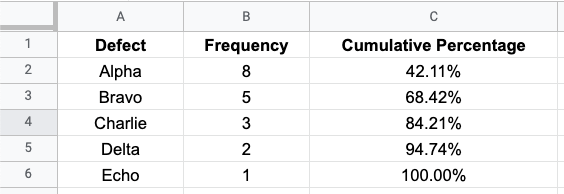
As you can see in column C from the table above, the cumulative percentage runs to 100% to provide the entire scope of contribution.
Don’t worry if you’re not drawing any conclusions yet. We’ll bring in the chart and help you understand it all in the following steps.
4. Add a combo chart to the data
Arguably the easiest step of the whole process is adding a combo chart using the data above. Again, Google Sheets makes this pretty easy.
Highlight all data, including titles.
Using our example, highlight A1:C6. Using your data, just highlight everything. Once highlighted, click Insert in the bar at the top and select Chart.
There’s a strong probability Combo chart is the default selection. If not, select it from the Chart type dropdown under Setup. This is what it should look like (if not, go back a step to ensure you followed directions!):

Remember: Bar and line graph.
We are very close, but there’s still a crucial step missing — the cumulative percentage line graph isn’t quite where it needs to be
5. Finish with a right Y-axis
The last step is adding our right Y-axis.
Right-click on any of the blue bars in the chart and click Series when the dropdown menu appears, then select Cumulative Percentage.
When the menu pops up on the right, glance toward the bottom and choose the Right axis beneath the Axis dropdown.

Here’s the step where things get interesting. The blue bar chart will highlight which defects are most prevalent, and the c
Now we are talking.
The blue bar chart highlights which defects are most prevalent, and the cumulative red line determines how much of the total problem would be fixed if the highest few were addressed.
For example, if our fake company focused all their efforts on Alpha, Bravo, and Charlie defects, they’d resolve 80% of their total issues.
Next: Leap straight into the action and store your Pareto diagram in monday.com for future reference OR move on to another product line and repeat this process to find even more areas for improvement.
Getting the most out of the Pareto principle with monday.com
Creating a Pareto chart may help identify where to focus your efforts, but your work is far from over. Once you’ve identified the problem and know how you’ll solve it, the real work begins.
Here’s where having a Work OS like monday.com will aid you in making the most significant impact.
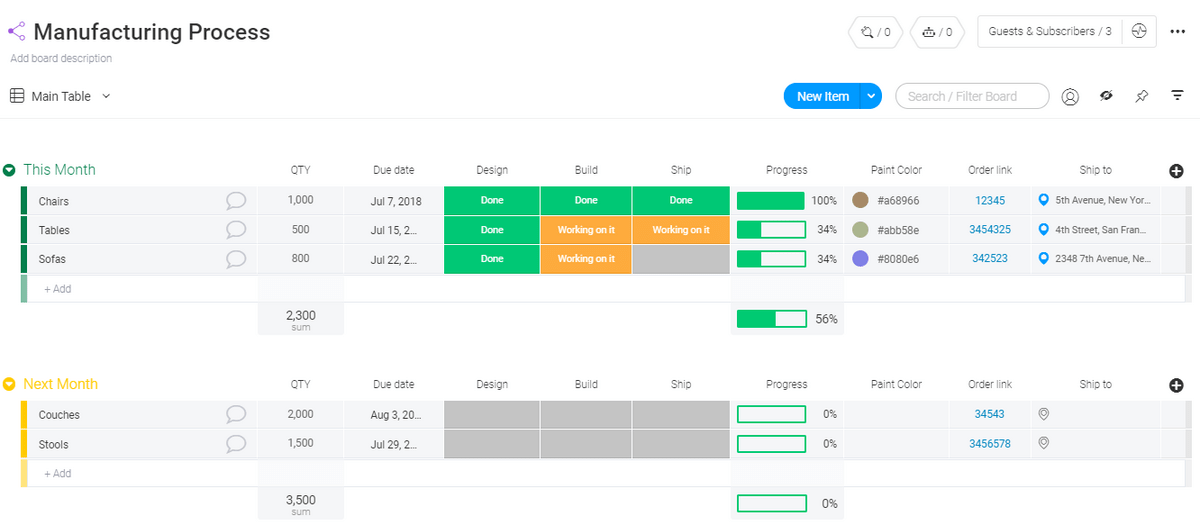
monday.com connects your organization in a way you’ve never seen before. You won’t need custom software for your sales team and another for HR.
You won’t need a separate one for customer service or order fulfillment. All you need is the right mix of monday.com boards.
To help you skyrocket your efficiency and double down on the crucial 20%, here are some other useful monday.com features you’re sure to love:
- 8+ beautiful data visualizations that help you see your data from fresh perspectives
- 200+ board templates so you kick your Pareto analysis findings into action
- Integrated communication and collaboration tools that make it easy to share documents, get status updates, and share new findings
- Dozens and dozens of integration possibilities which include Zapier that connect to over 3,000 apps
- Fully functional mobile applications so you’re always connected to your team and can easily view your stored Pareto charts on the go
The list of monday.com features that’ll improve your efficiency is seemingly endless.
Finding more ways to be productive
Anyone can make better decisions when they leverage the power of Pareto charts and take action with monday.com.
Not only will you have the information you need to make more impactful decisions, but you’ll also get a streamlined Work OS that genuinely makes your life easier so you can focus on what matters most.
f you’re looking to boost your improvement efforts and make the most significant impact possible for your organization, give our Manufacturing Order Tracking template a try.


